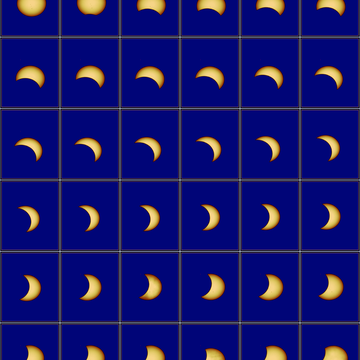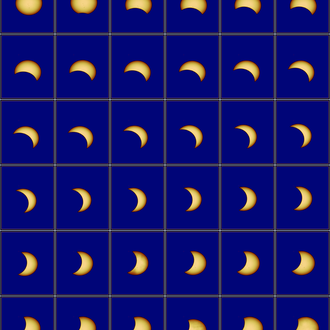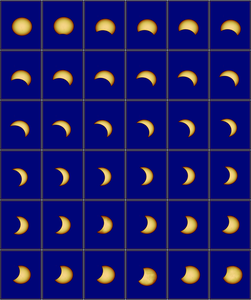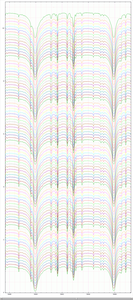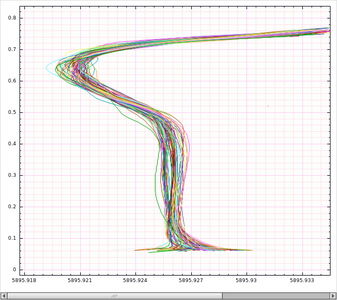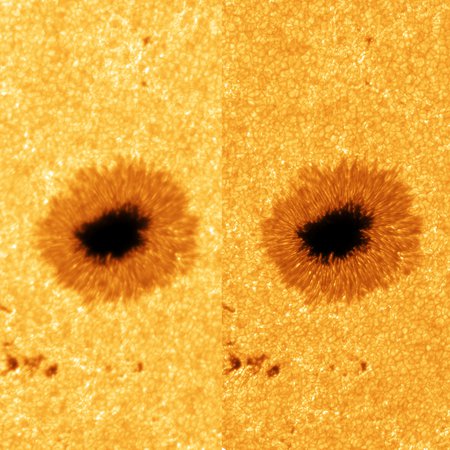Solar eclipse in one hundred spectra
A solar eclipse gives researchers the opportunity to observe parts of the sun that are normally invisible. With the Solar Disk Integrated Telescope (SDI) on Mount Graham in Arizona, USA, scientists of the Leibniz Institute for Astrophysics Potsdam (AIP) have remotely observed the solar eclipse on 21 August 2017. During the course of the eclipse, they obtained about one hundred spectra in two wavelength regions. The SDI feeds light into the PEPSI high-resolution spectrograph in the pier of the Large Binocular Telescope (LBT).
“The spectra that we obtained are highly dynamic,” explains AIP researcher Dr. Ilya Ilyin. “The origin of the light we measured lies in different areas of the Sun, for that reason their shape is slightly alternating.” The solar eclipse made the chromosphere better visible – the layer of the Sun’s atmosphere that is above the photosphere but below the corona, its outermost layer. Usually, the chromosphere is very difficult to see against the brightness of the inner photosphere. Only if the moon obscures the photosphere during an eclipse, chromospheric lines from the solar limb contribute to the spectrum.
In Arizona, there was a partial eclipse visible on 21 August 2017, which means that the moon was partially obscuring the innermost layer of the Sun’s atmosphere. “The chromospheric lines got increasingly stronger because the photosphere was more and more obscured,” says Ilyin. The researchers were performing analysis of the so-called Sodium D1 line that is formed in the solar chromosphere. They obtained around one hundred spectra during the course of the eclipse between 9:16 MST and 12:03 MST in the two wavelength regions 422 to 477 and 536 to 628 nanometers.
The spectrograph PEPSI, built by the AIP in Potsdam, has been installed on the LBT in 2015. The LBT uses two 8.4 meters large mirrors, which make it effectively an 11.8 meter telescope. The objective for the solar telescope SDI is to take high signal-to-noise solar spectra continuously on every day over the whole solar magnetic cycle to study the pressure modes of solar pulsations in high resolution. “Our main goal is to compare the solar surface with the surfaces of other stars and thereby better learn about its surface magnetism”, says the PEPSI Principal Investigator Prof. Dr. Klaus Strassmeier. The reseachers also want to determine if the line profiles vary along the course of a solar cycle.
Scientific contacts:
Dr. Ilya Ilyin, ilyin@aip.de, +49 331 7499-269
Prof. Dr. Klaus G. Strassmeier, kstrassmeier@aip.de, +49-331-7499-223
A solar eclipse gives researchers the opportunity to observe parts of the sun that are normally invisible. With the Solar Disk Integrated Telescope (SDI) on Mount Graham in Arizona, USA, scientists of the Leibniz Institute for Astrophysics Potsdam (AIP) have remotely observed the solar eclipse on 21 August 2017. During the course of the eclipse, they obtained about one hundred spectra in two wavelength regions. The SDI feeds light into the PEPSI high-resolution spectrograph in the pier of the Large Binocular Telescope (LBT).
“The spectra that we obtained are highly dynamic,” explains AIP researcher Dr. Ilya Ilyin. “The origin of the light we measured lies in different areas of the Sun, for that reason their shape is slightly alternating.” The solar eclipse made the chromosphere better visible – the layer of the Sun’s atmosphere that is above the photosphere but below the corona, its outermost layer. Usually, the chromosphere is very difficult to see against the brightness of the inner photosphere. Only if the moon obscures the photosphere during an eclipse, chromospheric lines from the solar limb contribute to the spectrum.
In Arizona, there was a partial eclipse visible on 21 August 2017, which means that the moon was partially obscuring the innermost layer of the Sun’s atmosphere. “The chromospheric lines got increasingly stronger because the photosphere was more and more obscured,” says Ilyin. The researchers were performing analysis of the so-called Sodium D1 line that is formed in the solar chromosphere. They obtained around one hundred spectra during the course of the eclipse between 9:16 MST and 12:03 MST in the two wavelength regions 422 to 477 and 536 to 628 nanometers.
The spectrograph PEPSI, built by the AIP in Potsdam, has been installed on the LBT in 2015. The LBT uses two 8.4 meters large mirrors, which make it effectively an 11.8 meter telescope. The objective for the solar telescope SDI is to take high signal-to-noise solar spectra continuously on every day over the whole solar magnetic cycle to study the pressure modes of solar pulsations in high resolution. “Our main goal is to compare the solar surface with the surfaces of other stars and thereby better learn about its surface magnetism”, says the PEPSI Principal Investigator Prof. Dr. Klaus Strassmeier. The reseachers also want to determine if the line profiles vary along the course of a solar cycle.
Scientific contacts:
Dr. Ilya Ilyin, ilyin@aip.de, +49 331 7499-269
Prof. Dr. Klaus G. Strassmeier, kstrassmeier@aip.de, +49-331-7499-223
Images
The partial eclipse as observed on Mount Graham in Arizona, USA.
Big screen size [1000 x 1192, 220 KB]
Original size [1290 x 1538, 270 KB]
Changes of the line asymmetry of all Na D1 spectra, which were taken during the solar eclipse.
The Sodium D2 and D1 lines, formed in the solar chromospere. All spectra recorded during the observation with SDI in two wavelength regions. This high quality spectrum exemplifies the abilities of PEPSI.
